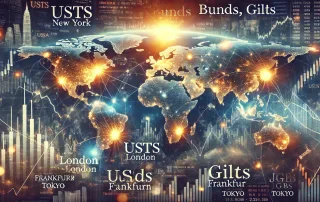Middle East Tensions: How Drone Attacks Impact Forex Markets

Drones and Defense: Unpacking the Latest Market Moves in the Middle East
The Middle East is never a dull place, and neither is the Forex market. While traders sip on their morning coffee, air defense systems are going off in southern Homs, Israeli warplanes are taking a joyride over Beirut’s southern suburbs, and Iran is lining up for a chat at the negotiation table. You might think, what on earth do UAVs and missile warnings have to do with Forex? Well, grab your trading journal, because we’re about to explore how geopolitics in the Middle East might make or break your next trade. And yes, I promise to make it a fun ride—like the kind you get when you realize the “quick trade” you made was actually on the wrong currency pair.
The Domino Effect: How Middle East Tensions Ripple into Forex
Alright, let’s break this down. Syria’s air defense system just sprang into action against a UAV (Unmanned Aerial Vehicle) over southern Homs. Now, while the average person might yawn, thinking “another day, another drone,” a Forex trader knows better. Any sign of escalating military action can stir up risk sentiment faster than you can say “pip.” Typically, this news will strengthen safe-haven currencies like the Swiss Franc (CHF) or the Japanese Yen (JPY). It’s like the market sees trouble brewing, and it packs its bags to move somewhere “safer.” So, if you’re trading exotic pairs or anything sensitive to Middle Eastern turmoil, watch out—the big money could flow out faster than those $9-per-month streaming subscriptions.
The Empathy Angle: Iran Wants to Negotiate (Kind Of)
In another twist, Iranian Foreign Minister Araqchi has voiced readiness to negotiate. It’s almost like Iran’s trying to join the ultimate trade negotiation table. Except, rather than swapping candlesticks for Fibonacci levels, they’re dealing in nuclear talks and sanctions relief. If you’re keeping your finger on the Forex pulse, this type of news could mean potential easing of tensions, which would soften oil prices and, in turn, impact petrocurrencies like the Canadian Dollar (CAD) or the Norwegian Krone (NOK). In simpler terms: less drama, more supply, lower prices.
Think of it like this: A trader sees Iran’s readiness to chat as that friend who offers to “talk things through” after a heated group text argument. Everyone calms down, and maybe—just maybe—oil prices drop as the dust settles. This scenario could also make the riskier currencies slightly more attractive again. Maybe it’s time to give a little more love to the Aussie Dollar (AUD) or even to make a cautious revisit to those emerging market currencies.
Israel’s Army and a Game of Chicken with Beirut
The Israeli army sent warnings of strikes on buildings in the southern suburbs of Beirut, then followed up with air raids. It’s like telling your neighbor you’ll throw a party and then cranking the music up just to make a point. For traders, this kind of escalation means renewed fears across the board—and markets hate uncertainty. With drone attacks reported by Iraqi armed factions targeting northern Israel, we see a brewing tension that’s likely to be bullish for the USD/JPY pair or bearish for emerging market currencies.
How Geopolitics Plays into Forex Strategy
This is where things get interesting. Traders often look at fundamental analysis as a “broad strokes” kind of deal, but geopolitics is all about nuance—it’s like adding shading to the coloring book of Forex trading. Knowing that tensions are heating up in the Middle East, you’d expect more volatility in oil and gas prices, which means watching the CAD and NOK closely. If you’re a bit risk-tolerant (or just want to pretend you are), you could also look into short-term setups that capitalize on the instability—think smaller timeframes, tighter stop losses, and a more nimble approach to your position sizing.
Biden, Ukraine, and That Odd Mention of Trump
Meanwhile, across the Atlantic, the White House noted that President Biden emphasized the need to back Ukraine during a meeting with… President-elect Trump? Wait, what? Unless we’re living in a time warp or the news feed has glitched harder than a badly executed EA, this is probably a typo. But let’s talk implications—the real relationship here is between the U.S., Ukraine, and the perceived threat from Russia. Any signs of increasing support to Ukraine often lead to market tension that benefits safe-haven assets like gold (XAU/USD) and the JPY. If military support heightens, traders may also look towards the Ruble (RUB) for potential volatility, especially against the backdrop of shifting energy exports in Eastern Europe.
Turning News into Trades: Key Takeaways
So, how do you turn the mess that is global news into something actionable?
- Safe Haven Scenarios: Any rise in conflict in the Middle East tends to be bullish for the Swiss Franc (CHF) and Japanese Yen (JPY). When the risk dial turns up, so does demand for these currencies.
- Oil Drama: Keep a close eye on oil-related news—if Iran negotiates, that could ease oil prices, affecting currencies like CAD and NOK. If tensions escalate, oil prices could spike, and so might those petrocurrencies.
- Equity Market Influence: Heightened geopolitical risks can send traders to cover with assets like gold (XAU) or simply pull out of equities, which could weaken indices. Watch how indices respond to tension—they’re often a leading indicator for currency movement.
Where to From Here?
Global news can feel like trying to ride a rollercoaster in the dark, but it’s also an opportunity. With every air defense activation, military threat, or negotiation table plea, there’s a potential movement in the Forex market—it’s all about reading between the headlines. What the average person sees as mere news clips, you’re taking as cues for trades, spotting the unseen impact in real-time. And remember, the news cycle isn’t going anywhere, so your job is to keep riding the waves—albeit with a well-considered strategy and, as always, a smile on your face. Because if there’s one thing we know about trading, it’s that you can’t control the world, but you sure can make a plan for how to trade its surprises.
—————–
Image Credits: Cover image at the top is AI-generated

Anne Durrell
About the Author
StarseedFX delivers timely Forex news and market insights, thoughtfully edited and curated by Anne Durrell. As a seasoned Forex expert with over 12 years of industry experience, Anne turns complex market shifts into clear, engaging, and easy-to-understand updates.
From decoding the latest trends to writing her own in-depth analyses, Anne ensures every piece is both informative and enjoyable. If you found this article helpful, don’t forget to share it with fellow traders and friends, and leave a comment below—your insights make the conversation even richer! Follow StarseedFX for fresh updates and stay ahead in the dynamic world of Forex trading.






